












|
 |
 |

 round
will be broken by the end of 2005
round
will be broken by the end of 2005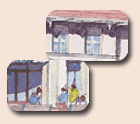
on a new $55 million medical education building that will be Emory
University School of Medicine’s first permanent home on campus.
The education facility is actually three buildings unified into
a single, high-tech education complex. A new Hall of Medicine will
bridge the past to the present, both physically and symbolically, with connections to the Anatomy and
Physiology buildings—which hold much of the school’s
history. It will be ready for occupancy by late 2007.
physically and symbolically, with connections to the Anatomy and
Physiology buildings—which hold much of the school’s
history. It will be ready for occupancy by late 2007.
The 162,000- square foot facility
doubles the number of seats for teaching. A redistribution of space
will better reflect the emerging curriculum with three 160-seat
auditoriums and 18 small group classrooms. In addition to these
“hard seats” for classes, “soft seats” for
studying abound in separate lounges for medical students and graduate
students in the biomedical sciences. A coffee lounge will provide
additional gathering and study space.
Other facilities include an expanded
gross anatomy laboratory, two teaching computer laboratories, and
a computer support room for students. In keeping with the university’s
campus master plan, green space at an entrance plaza will have park-like
landscaping and outdoor seating. The entrance lobby will feature a soaring atrium,
offering an abundance of natural light.
outdoor seating. The entrance lobby will feature a soaring atrium,
offering an abundance of natural light.
The building is generating enthusiasm
among Emory administrators, faculty, and students. In fact, Dean
Lawley is leading by example as a member of the school's 150 Society,
composed of those who have donated $150,000 or more to the building
in honor of the 150th anniversary. “I love Emory, and medical
education is core to our mission,” Lawley says. “If
I can help get this building built, I will.”
Patients, too, are showing a strong
commitment to the new construction. “It is unusual to have
so much support for a medical school building from patients,”
says Health Sciences Center Vice President for Development Phil
Hills. “But our patients really see how important this building
is for the continued excellence of medicine at Emory.”
On these pages, we highlight the gifts
of only
a few of those who are supporting the construction of this state-of-the-art
teaching facility. If you’d like to join them in building
a home that will empower the School of Medicine’s service
for its next 150 years, contact Phil Hills, Woodruff Health Sciences
Center, 1440 Clifton Road, Suite 440, Atlanta, GA 30322, 404-727-3518,
phills@emory.edu.
|
 |
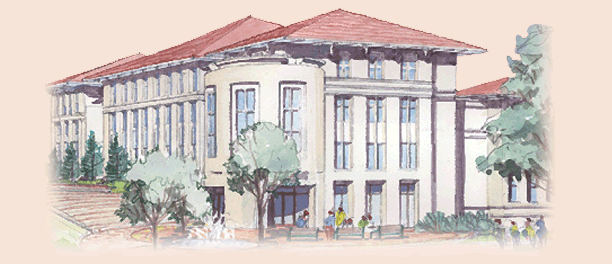 |
 |



 he
late Charles F. Evans and his wife, Peggy Evans, wanted to impact
the future of health care in Atlanta. The Atlanta philanthropists,
whose wealth came from a chain of metro-Atlanta car dealerships,
made good on that wish by leaving the bulk of their estate—some
$15 million—to Emory’s medical and nursing schools. he
late Charles F. Evans and his wife, Peggy Evans, wanted to impact
the future of health care in Atlanta. The Atlanta philanthropists,
whose wealth came from a chain of metro-Atlanta car dealerships,
made good on that wish by leaving the bulk of their estate—some
$15 million—to Emory’s medical and nursing schools.
Both the Evanses, who were patients
of Emory internist Dave Roberts, died of cancer. Their gift, according
to Sarah Pilgrim, executor of the estate and an employee and close
friend of the Evans family, “reflects their own appreciation
for the kind of medical and nursing care they both received from
Dr. Roberts and the nurses at Emory University Hospital.”
Almost $12 million of the gift is supporting
dramatic interior renovations of the Anatomy and Physiology buildings,
first built in 1917. These twin wings, which will be renamed for
Charles and Peggy Evans, will serve as training spaces for anatomy
and provide research space for anatomy and other areas for teaching.
In addition, the Evans bequest created an endowed chair in the Department
of Medicine to honor Dave Roberts, and it established an endowment
to provide annual income to the department. The chair allows its
holder to devote more time to teaching. The endowment supports new
programs in the Department of Medicine that enhance student training
through classroom, patient care, and research experiences.
In one of Charles Evans’s last
conversations with Emory development staff, he expressed his intention
to “leave a lot of money to Emory because Emory does so much
good.” The Evanses’ gift ensures that good continues. |
 |
 |

 |


 illy
R. Jones had been illy
R. Jones had been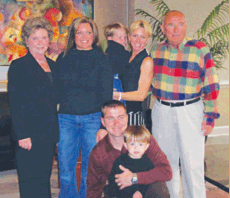
to several medical centers, and no one could tell him what
was wrong. A vibrant businessman whom his family describes
as “having the energy of three people,” he found
himself extremely tired. Then Jones met Emory internist Dave
Roberts who took a look at his patient's seemingly tanned
skin, heard the symptoms of muscle weakness and fatigue, and
made the diagnosis within 15 minutes: Addison's disease.
At first, the independent Jones
refused to believe that he would have to be dependent on medicine
and refused to take the prescribed medication. Roberts persisted
with phone calls until the reluctant patient relented. The
condition requires ongoing monitoring and treatment, but Jones
has recovered his energy.
The entire Jones clan—Billy,
his wife Mary Lou, his daughter Laytona, and his son, the
former NASCAR driver Buckshot Jones—counts Roberts and
his family as close friends. “The whole family loves
Dr. Roberts,” says Laytona. “It wasn't easy to
find something to do for him.” However, they decided
on a gift to the new medical education building for a classroom
in honor of Roberts. “Dad is very excited by this opportunity
to give back to Dr. Roberts and the entire Emory Clinic this
small token of his appreciation for what they gave him in
diagnosing his condition and, essentially, giving him his
life back with just a few minor adjustments,” Laytona
says.

|
 |
 |
 |
 |

 ike
a good genealogist, Sidney H. Yarbrough III, 63M, can trace four
generations of his family’s medical training back to a single
root: Emory. ike
a good genealogist, Sidney H. Yarbrough III, 63M, can trace four
generations of his family’s medical training back to a single
root: Emory.
The oldest relative is James Dean
DeLamar, who attended the Atlanta College of Physicians and Surgeons,
a forerunner of Emory's medical school, in 1902–1903. DeLamar
is the grandfather of Yarbrough’s wife, Rebecca. Next comes
Sidney H. Yarbrough Jr., his father, who finished in the early 1920s
at Atlanta Southern Dental College, which also was affiliated with
Emory. Yarbrough himself went to college and medical school at Emory,
returning after service in the Air Force to complete an orthopaedics
residency from 1966 to 1970. In the fourth generation, Robert Knox
Yarbrough, Sidney’s and Becky’s son, graduated from
Emory University School of Medicine in 2001.
“We have four generations of
participation in an institution that I happen to be very proud of,”
says Sidney Yarbrough. “I spent the most time of anyone. We
feel we have a fairly significant IOU.”
Sid and Becky Yarbrough have been
making good on that IOU with donations of time and money to the
medical school for many years. They serve as members of the school’s
Medical Advisory Board. In 1998, Becky endowed a scholarship in
her husband’s honor. This year, they will make a new gift
of $150,000 to support a group learning room in the new medical
education building.
“Emory got me where I am,”
says Sidney Yarbrough, “and I want to help them the best I
can. I’m paying back a large debt.”
 |
 |
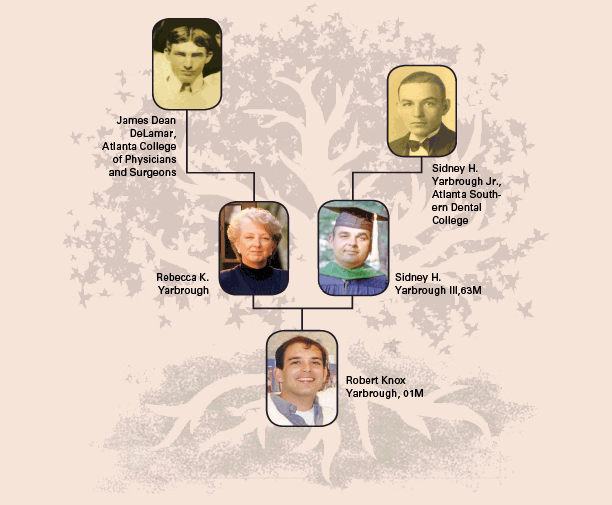 |
 |

 |


 hen
Goodwin Breinin, hen
Goodwin Breinin,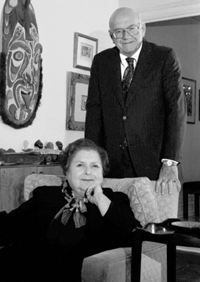
40G, 43M, was a medical student at Emory in the early 1940s,
he played touch football on the lawn between the Anatomy and
Physiology buildings. More than 60 years later, Breinin is
contributing $10,000 to the new medical education building
that will be erected on that same lawn. “My gift to
the medical school is both an acknowledgement of my great
debt to Emory and a tribute to Dean Tom Lawley, whose friendship
I treasure,” he says.
Breinin’s graduate school
professors at Emory fostered his interest in the biologic
sciences. He entered medical school with a class that “had
the great good fortune to study under newly recruited Professor
of Medicine Eugene Stead,” Breinin says. “He brought
with him a crew of enfant terrible medical scientists who
were developing the field of physiologic and laboratory-oriented
medicine,” a radical departure for the time and one
which fired Breinin’s imagination and led him into academic
medicine.
Following military service,
he entered an ophthalmology residency at New York University
School of Medicine in 1947. He later became the Daniel B.
Kirby Professor of Ophthalmology there, a position in which
he is still active as a researcher and teacher. Breinin chaired
the Department of Ophthalmology beginning in 1959 and for
the next 41 years— “a bit of a record,”
he says.
“All of this would not
have been possible without my Emory experience,” says
Breinin, a recipient of the Emory Medal.
The gift from Breinin and his
art historian wife, Rose Helen, is the couple’s second
to the medical school. In 1996, Emory established the Breinin
Lectureship in the Basic Sciences.
Before the new building is erected,
Breinin would like to play touch football on the lawn one
last time. However, at 86, he admits, “I find that prospect
somewhat dubious.”

|

|
|
 |
 |


 or
the sixth straight year or
the sixth straight year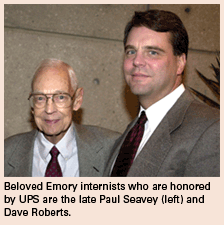
running, FORTUNE magazine has rated UPS as the world’s
most admired company in its industry. Of the attributes ranked in
the annual survey, UPS received high marks not only for the quality
of management but also for use of corporate assets and social responsibility.
The world’s premiere package delivery company takes that charge
seriously. In 2004 alone, UPS gave nearly $40 million worldwide
in philanthropic grants.
According to Evern Cooper Epps, president
of the UPS Foundation, the company historically has focused its
gifts on three areas: hunger, literacy, and, most recently, volunteerism.
To have more impact, UPS aligns its philanthropy with organizations
and projects that show solid operations, sustainability, and an
element of volunteerism.
Recently, the UPS Foundation has pledged
$250,000 to honor Emory internist Dave Roberts and to support the
medical school’s new medical education building. “We
see Emory as a key 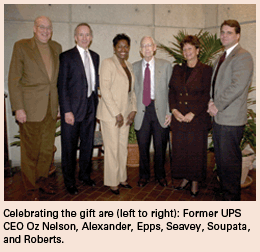 community
stakeholder, providing excellent service,” says Epps. “Like
UPS, Emory is part of the fabric of our community. In our giving,
we try to align our objectives with partners who share our vision.” community
stakeholder, providing excellent service,” says Epps. “Like
UPS, Emory is part of the fabric of our community. In our giving,
we try to align our objectives with partners who share our vision.”
That vision includes building healthy
communities. “UPS believes that an important component of
building strong and healthy communities is to ensure that quality
medical care is available. That begins with a first-rate medical
education,” says Lea Soupata, UPS senior vice president of
human resources. “Given Emory’s reputation for academic
excellence and Dr. Roberts’ character and dedication to the
craft of medicine, we believe our gift is an appropriate tribute.”
The latest UPS support builds on a
gift of $100,000 last fall to Emory to help endow a chair in the
late Paul Seavey’s name. Epps describes Seavey, who treated
many of the business executives in Atlanta, including those at UPS,
as a “legacy leader.”
She sees Roberts, who took on many
of Seavey’s patients, as carrying on that legacy. “He
demonstrates the highest professionalism and can articulate Emory’s
vision,” says Epps, who counts herself fortunate as one of
his patients. “You couldn’t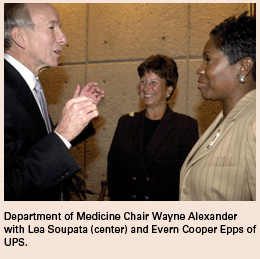 meet a more caring person.”
meet a more caring person.”
The UPS Foundation hopes its gift
will serve as “a catalyst to jump-start the new medical education
building,” Epps says. “We want to be a good corporate
citizen and a role model to others in this groundbreaking opportunity
for our community.” |
 |
| |
|
|
|
| |
|
|
|
| |
|
|
|
| |
|
|
|
|
|
|





